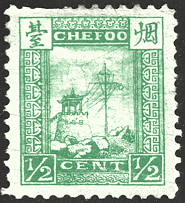Chefoo
Appearance
English
[edit]
Etymology
[edit]Borrowed from Mandarin 芝罘 (Zhīfú).
Pronunciation
[edit]- enPR: jǔʹfo͞oʹ
Proper noun
[edit]Chefoo
- Dated form of Zhifu; (dated) Synonym of Yantai
- 1896, Alex Armstrong, In a Mule Litter to the Tomb of Confucius[1], James Nisbet & Co., →OCLC, page 5:
- We left Chefoo at 2.30 P.M. on Monday, 15th December, and had a pretty rough bit of road immediately after we started. Going up a steep pass, almost due south of Temple Hill, made the mules blow in a most unsatisfactory manner. I was well done-up myself when I got to the top, and was more than pleased to rest a little and look down upon fading Yen-t'ai (the Chinese name for Chefoo), before the hills would shut it from my sight for weeks.
- 1898, John D. Ford, An American Cruiser In The East; Travels And Studies in the Far East; The Aleutian Islands, Behring’s Sea; Eastern Siberia, Japan, Korea, China, Formosa, Hong Kong, and the Philippine Islands[2], 2nd edition, New York: A. S. Barnes and Company, page 235:
- The population of Chefoo is about thirty-three thousand, of whom about six hundred are foreigners. Its trade is principally in beans and beancake, of which enormous quantities are sent to the southern ports of China.
- 1904, Robert Coventry Forsyth, editor, The China Martyrs of 1900[3], page 251:
- This conviction impressed itself on Mr. John Fowler, the United States Consul in Chefoo, who, with characteristic energy, set about to secure the safety of the missionaries in the province of Shantung, of which a large number were under his consular authority, as citizens of the United States of America.
- 1922 June 3, “The Mineral Resources of Shantung”, in The Weekly Review of the Far East[4], volume XXI, number 1, Shanghai, →OCLC, page 7, column 2:
- Forty li southwest of Ninghai, now named Mowping (牟平) and 60 li southeast of Chefoo, there is a river flowing from the Kweishan, and in it is found gold placer.
- 1934, George Babock Cressey, China's Geographic Foundations: A Survey of the Land and Its People[5], McGraw-Hill Book Company, Inc., page 222:
- About two-thirds of the immigrants enter Manchuria by sea and a third come overland. Those arriving by boat come from Tsingtao, Chefoo, or Tientsin to Dairen or Yingkow, while those coming overland travel on the Peiping-Liaoning Railway or journey on foot.
- 1999, Margaret Negodaeff-Tomsik, “Arrival 1877”, in Honour Due: The Story of Dr. Leonora Howard King[6], Canadian Medical Association, →ISBN, →OCLC, page 38:
- At this point, Leonora Howard's real adventure begins. She will board another steamer, this one bound for Tientsin, some 1,600 kilometres to the north. Leaving the filthy harbour, the steamer will turn east again into the relative freshness of the Yellow Sea, heading for Tsingtao, Chefoo, and finally the Taku sandbar outside of Tientsin, where loom to long low forts.
- 2004, Frances Osborne, Lilla's Feast: A True Story of Food, Love, and War in the Orient[7], Ballantine Books, →ISBN, page 14:
- In 1877, Chefoo's exports came from the town's agricultural hinterland of the Shantung Province.
- 2016, Richard Wright, “The Chinese Flagship Hai Chi and the Revolution of 1911”, in Warship 2016[8], Bloomsbury, →ISBN, →OCLC, page 151, column 1:
- Then, on 25 February 1949 there was a mutiny on board the Chongqing, and she absconded that night for the north and the PLA-held port of Yentai (formerly Chefoo).
Further reading
[edit]- “Chefoo”, in Collins English Dictionary.
- “Chefoo, pn.”, in Lexico, Dictionary.com; Oxford University Press, 2019–2022.
- “Chefoo”, in OneLook Dictionary Search.
- “Chefoo”, in Merriam-Webster Online Dictionary, Springfield, Mass.: Merriam-Webster, 1996–present.
- “Chefoo” in TheFreeDictionary.com, Huntingdon Valley, Pa.: Farlex, Inc., 2003–2025.

